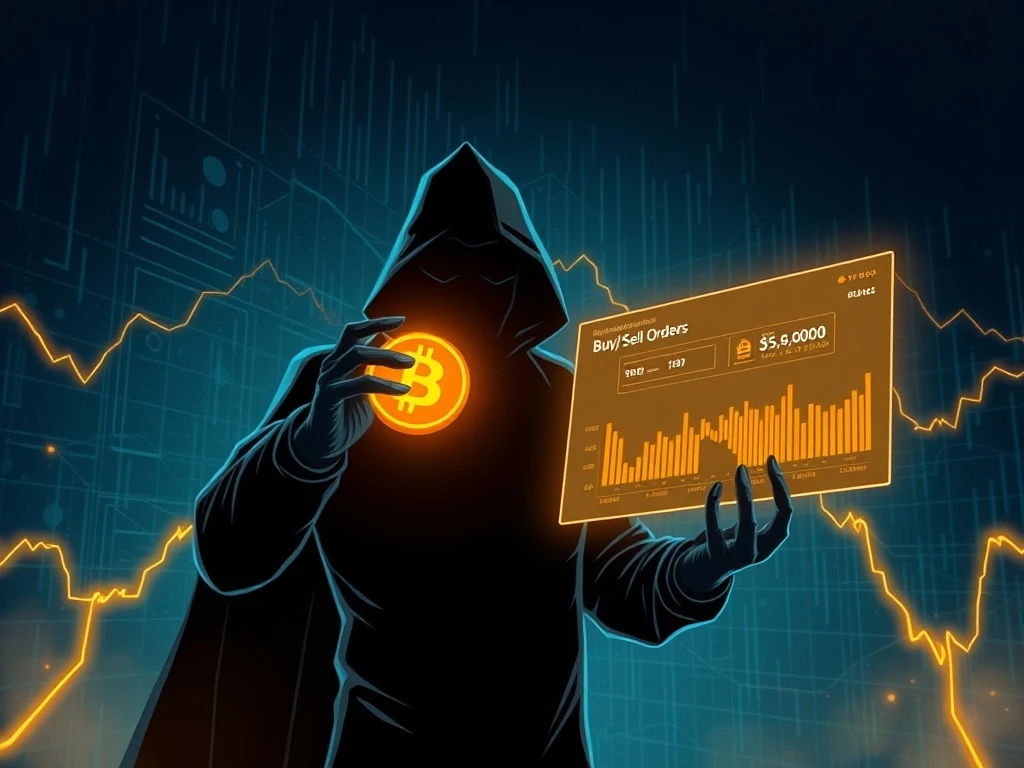Crypto Spoofing: Unveiling the Perilous Deception of Fake Orders

Ever wondered why the crypto market sometimes behaves in ways that just don’t make sense? One moment, a massive buy order appears, hinting at a price surge, and the next, it vanishes into thin air, leaving traders confused and out of pocket. This isn’t just random market noise; it’s often the calculated act of crypto spoofing, a deceptive tactic designed to trick you and other investors. Understanding this manipulation is crucial for anyone navigating the volatile world of digital assets.
What is Crypto Spoofing? Unmasking the Illusion
At its core, crypto spoofing is a form of market manipulation where traders place large, non-bona fide buy or sell orders with no intention of executing them. Their goal? To create a false impression of market demand or supply, influencing others to make trades that ultimately benefit the spoofer. Imagine a trader placing a colossal buy order for Bitcoin (BTC). This ‘wall’ of demand can trick other traders and automated bots into believing a significant price increase is imminent, prompting them to buy in. However, just as the price begins to climb, the spoofer swiftly cancels their fake order, then sells their own holdings at the inflated price, cashing in on the induced market movement.
This tactic thrives on deception. Instead of genuine trading intent, spoofers aim to generate a false sense of market sentiment—either bullish excitement or bearish panic—to manipulate others. It’s often hard to detect in real-time and can mislead both human traders and sophisticated algorithms that rely on order book data. While strictly illegal in traditional financial markets, crypto markets, especially those less regulated, continue to grapple with this pervasive and damaging practice.
How Market Manipulation Crypto Works: A Deep Dive
Market manipulation crypto tactics like spoofing capitalize on the digital asset market’s inherent volatility and emotional nature. Cryptocurrencies are renowned for extreme price swings, meaning even subtle signals can trigger significant price movements in seconds. Spoofers exploit this sensitivity by strategically placing large, fake buy or sell orders. These orders create the illusion of strong demand or selling pressure without any actual intent for them to be filled.
Here’s a closer look at the mechanics:
- Creating False Demand: A spoofer places a large buy order far from the current market price, making it appear as if there’s significant buying interest. This might convince others that the price is about to rise, leading them to buy. Once the price moves up, the spoofer cancels their original fake order and sells their own assets at the higher price.
- Inducing Panic Selling: Conversely, a spoofer might place a massive sell order, creating a ‘sell wall’ that suggests overwhelming supply. This can cause panic among holders, leading them to sell their assets, pushing the price down. The spoofer then cancels their fake order and buys back assets at a lower price.
This strategy is particularly effective in fluctuating markets where investor behavior is often driven by emotions like Fear of Missing Out (FOMO) or Fear, Uncertainty, and Doubt (FUD). Automated trading bots, which depend heavily on real-time order book signals, are especially vulnerable to spoofing. They can react instantly to large orders without questioning their validity, amplifying the spoofer’s intended effect. This fuels unnecessary volatility and can severely impact liquidity, especially when large trades are involved.
It’s important to distinguish spoofing from Maximal Extractable Value (MEV). While both can harm traders, MEV occurs when miners or validators reorder or insert blockchain transactions to extract profit, often by frontrunning or sandwiching user trades. Spoofing, on the other hand, manipulates trading bots and human perception through fake orders on an exchange’s order book. Spoofing directly distorts market prices by creating false signals, whereas MEV leverages the sequence of transactions on the blockchain itself.
This deceptive cycle can attract more bots and individual investors, intensifying price fluctuations. Despite efforts by some exchanges to identify and stop spoofing, it remains a persistent challenge in less regulated or closely monitored cryptocurrency marketplaces. Sometimes, the goal of spoofing isn’t even direct financial gain; it can be to trigger liquidation cascades, advance a specific narrative, or sway public opinion about a particular coin or exchange.
The Deceptive Art of Fake Crypto Orders
The core of spoofing lies in the strategic placement and rapid cancellation of fake crypto orders. These orders are carefully designed to look legitimate enough to influence market participants, yet the spoofer never intends for them to be filled. One particularly sophisticated variant is ‘layer spoofing.’
Layer spoofing involves placing multiple fake buy or sell orders at different price levels, creating an even more convincing illusion of strong market interest. Unlike basic spoofing, which might use one large fake order, layer spoofing spreads several smaller ones across the order book. This makes the manipulation appear more organic and harder to detect, as it mimics genuine market depth.
If you observe several orders stacked at regular intervals that suddenly disappear as the market price approaches them, it’s a strong indicator of layer spoofing. This creates a false sense of liquidity and price support/resistance, leading unsuspecting traders to make misguided decisions.
It’s also worth noting the difference between spoofing and wash trading. While spoofing uses fictitious orders to move prices without execution, wash trading involves simultaneously buying and selling the same asset to create artificial trading volume. Both are illegal market manipulation tactics frequently observed on unregulated crypto exchanges, aiming to deceive investors about an asset’s true demand or liquidity.
Is Crypto Spoofing Legal? Unpacking the Regulations
The question of legality surrounding crypto spoofing is critical. In most major jurisdictions, crypto spoofing is indeed illegal, as it fundamentally creates a false impression of market activity. In the United States, for instance, it’s considered a federal crime under the Dodd-Frank Act of 2010. Agencies like the Commodity Futures Trading Commission (CFTC) actively monitor spoofing and other illegal crypto trading tactics, with potential sanctions including significant fines and even up to 10 years in prison per violation. Similarly, the US Securities and Exchange Commission (SEC) strictly enforces rules against market manipulation, including spoofing.
Internationally, regulatory bodies like the UK’s Financial Conduct Authority (FCA) also apply stringent rules to preserve market integrity. Major exchanges are increasingly responding by implementing real-time detection techniques aimed at stopping spoofing before it can significantly impact prices.
Despite increased regulatory oversight, spoofing remains a persistent problem in the cryptocurrency market. A prominent example occurred in April 2025, when a massive $212-million Bitcoin sell order appeared on Binance at $85,600—well above the prevailing market rate—only to vanish moments later. This sudden disappearance rattled traders, causing short-term volatility as the fake order distorted market sentiment and liquidity. While such behavior is clearly illegal in traditional finance, crypto markets, particularly those operating on offshore platforms, still navigate regulatory gray zones. Reports from Q1 2025 indicate that manipulation persists on popular exchange platforms, including Binance, MEXC, and Hyperliquid, even as institutional involvement in crypto grows.
How to Detect Spoofing Crypto: Signs and Strategies
Detecting spoofing crypto in real-time is challenging, demanding a keen eye for detail and an understanding of order book dynamics. While no method guarantees instant detection, recognizing key patterns can significantly help:
- Sudden Order Book Changes: Watch for unusually large orders that appear at key price levels (e.g., strong support/resistance) and then vanish rapidly before they can be executed. These ‘phantom’ orders are designed to create false demand or supply signals.
- High Frequency of Order Cancellations: A consistent pattern of placing sizable orders and then quickly canceling them, especially without execution, is a major red flag. Spoofers often engage in repetitive trading operations that follow specific routines.
- Liquidity Map Fluctuations: Tools that visualize order book depth or ‘liquidity maps’ can be invaluable. If a significant wave of liquidity suddenly disappears right before or during a price movement, it strongly suggests manipulation.
- Disjointed Price and Volume Moves: Be wary of unexpected price swings or volume spikes that aren’t supported by significant news, fundamental developments, or broader market trends. Such anomalies can often be attributed to spoofing activity.
Over time, persistent spoofing can erode confidence in a specific cryptocurrency or exchange, driving away legitimate investors. Although actions by authorities like the FCA and CFTC help deter spoofers, real-time identification remains difficult, especially on smaller exchanges with less stringent Know Your Customer (KYC) requirements. Nevertheless, the demand for greater transparency and more effective countermeasures continues to grow as crypto trading tricks evolve.
Crucial Steps to Protect Crypto Investors
Knowing how spoofing, wash trading, and similar manipulative tactics work is the first step toward becoming a more informed and resilient investor. While spotting these practices isn’t always easy, several precautions can help protect crypto investors from falling victim:
- Stick to Trusted and Well-Regulated Exchanges: Prioritize trading on platforms with a proven reputation for transparency, robust security, and compliance with regulatory standards. Regulated exchanges are more likely to have advanced systems in place to detect and prevent spoofing. Unregulated or offshore platforms often lack these safeguards, making them breeding grounds for manipulative practices.
- Examine Order Books for Unusual Patterns: Develop a habit of closely scrutinizing order books. Pay particular attention to unusually large orders that appear and vanish rapidly. These ‘phantom’ orders are designed to create false impressions of supply or demand. If you notice repeated patterns of such behavior or sharp price shifts without clear broader market context, treat them with extreme suspicion.
- Cross-Verify Market Trends: Never rely on a single source for market information. Compare price movements, trading volumes, and order book data across multiple reputable sources, such as CoinMarketCap, CoinGecko, and different exchanges. Significant discrepancies between platforms can be a strong indicator of manipulation occurring on one of them.
- Use Limit Orders and Trade Rationally: Instead of reacting emotionally to sudden market signals, always use limit orders to set your exact entry and exit points. This proactive approach protects you from overpaying during sudden upward swings or selling too low during rapid downward movements. Remember: If a market signal or opportunity seems too good to be true, it very likely is. Exercising extra caution is not just wise in volatile markets; it’s absolutely essential for your capital preservation.
Conclusion: Vigilance in a Volatile World
Crypto spoofing represents a significant threat to the integrity and fairness of digital asset markets. By understanding how traders employ fake crypto orders for market manipulation crypto, and by learning how to detect spoofing crypto, you empower yourself to navigate these complex waters more safely. The crypto landscape is evolving rapidly, with regulators striving to catch up to sophisticated tactics. As an investor, your best defense is continuous education, critical thinking, and disciplined trading practices. By choosing reputable platforms and staying vigilant, you can significantly protect crypto investors like yourself from deceptive schemes, ensuring a more secure and equitable trading experience. Stay informed, stay cautious, and trade smart.








